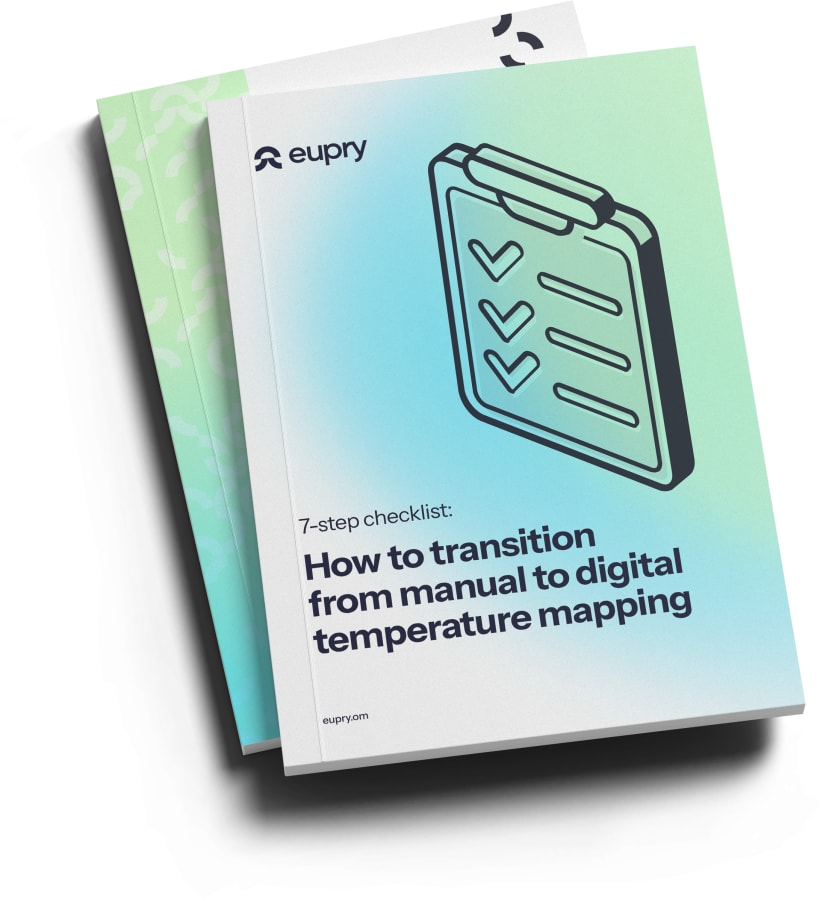
From manual to digital temperature mapping: A step-by-step guide for compliant automation

Jakob Konradsen

Thinking of (further) digitalizing your mappings? Learn how to move from a fully or partly manual process to efficient, compliant digital temperature mapping with this step-by-step guide for GxP.
Human error, inefficiency, and inconsistent practices across sites: Whether your procedures are fully manual or already partially digital, relying on manual temperature mapping processes can mean exposure to unnecessary risks – and spending excessive time and resources on validation.
Done right, digitalizing manual legacy processes is one of the most effective ways to improve temperature compliance and scalability across your operations.
This guide provides a roadmap for moving from manual to digital temperature mapping while avoiding the risks of a rushed or unstructured transition.
The article goes through:
The manual legacy: Why are many mapping processes still largely manual?
Despite the importance of temperature mapping of GDP, GMP, and other GxP-regulated environments, many organizations still rely on manual processes that involve spreadsheets, USB loggers, and paper-based protocols.
For many, the main reason for the manual approaches is that transitioning to digital temperature mapping processes is not straightforward. Without a structured approach, it brings its own risks, which is why the transition is often down-prioritized in favor of traditional approaches.
However, these approaches not only slow down teams but also introduce unnecessary risks and make it harder to scale, harmonize compliance, and share practices across sites and departments.
Digital temperature mapping tools offer a smarter alternative: Reducing human error, increasing efficiency, and creating audit-ready documentation automatically. However, a successful transition from manual to digital requires structure.
Also read: Temperature mapping buyer’s guideline - what to look for?
The 5 challenges of manual mapping –and the benefits of going digital
If done right, moving from manual to digital mapping (and other compliance procedures) is a strategic shift that solves long-standing challenges and brings a range of benefits, such as:
1. No more manual mistakes
Manual mapping: Comes with the risk of manual data errors Manual mapping often relies heavily on people entering data from USB loggers or handwritten forms into spreadsheets. This introduces room for mistakes, whether from typos, missed readings, or misaligned timestamps.
Digital mapping: Improves accuracy and eliminates transcription errors Advanced digital mapping solutions remove the need for manual input and can ensure traceable, timestamped records, which reduces human error and improves data integrity.
2. Spot problems before they escalate
Manual mapping: Deviations are often only caught after the study is complete In a manual setup, you typically only discover temperature excursions, equipment issues, or procedural problems after the mapping study has ended when it is too late to intervene or recover lost time.
Digital mapping: Enables immediate corrective action Many digital setups will provide live visibility into your studies as they happen, which means that your teams can act immediately to address any issues, adjust the environment, or stop the study to avoid wasting time and resources.
3. Faster mappings
Manual mapping: Slows down your operation Not surprisingly, manual workflows require more hands-on time than digital. Setting up loggers, downloading data, compiling it into graphs, and writing reports are just some of the time-consuming tasks characterizing traditional mapping processes, often requiring input from multiple team members to complete a study.
Digital mapping: Speeds up execution and reduces the team effort Digital solutions automate many of these steps and simplify others. Wireless loggers save time through automated data collection, reusable digital templates make planning less time-consuming, and digital analytics make reporting both easier and less prone to errors. What used to take days can now be done in hours – or less.
4. Less stress when audits come around
Manual mapping: Creates a lot of work during audits Preparing for audits can be a burden, and in manual setups, it often means hunting down spreadsheets, matching them to calibration records, and formatting the data into a readable report – all under time pressure.
Digital mapping: Easier audit reporting Having a digital mapping process will often make it possible to easily retrieve or generate reports with all documentation – logger IDs, calibration certificates, test protocols, and deviation records.
5. Consistency across sites
Manual mapping: Makes it difficult to standardize across locations** Manual methods can be hard to scale and harmonize. Different teams may use different processes, spreadsheets, or reporting formats, which can make it hard to ensure consistent quality and procedures across sites.
Digital mapping: Supports scalable and standardized compliance Digital mapping platforms make it simpler to roll out standardized protocols across multiple facilities and units. You can replicate validated workflows, reuse documentation templates, and ensure that all teams follow the same compliance approach, whether you are operating in one site or twenty.
How to successfully digitalize temperature mapping
Now that we have established why to digitalize, we are left with the “how” of it all. Although a digitalized mapping process will be the more efficient and reliable choice compared to a manual route, changing procedures and going from manual to digital come with risks and need to be handled with a strategic approach.
Here are the main steps to take to make sure your transition from manual to digital mapping is done in a secure, efficient way:
Assess your current mapping process
Mapping processes are rarely either 100% manual or 100% digital, nor are they 100% optimized or 100% inefficient. Begin with a detailed outline and evaluation of how temperature mapping is currently executed across your operation and where there are gaps that directly or indirectly impact compliance or efficiency.
Knowing your operation’s specific inefficiencies is needed to build a business case for digitalization and to identify which processes need to change to reduce compliance risk and improve operational reliability.
Some of the areas to review are:
- Data logging: Look at how data is collected and transferred. Transferring from USB loggers or manual data capture into spreadsheets introduces the risk of error, inconsistency in data handling, delayed insights, and non-traceable records.
- Visibility: Assess whether your team has continuous, current access to mapping progress and deviations. Without it, deviations are often discovered only after the study ends, which limits your ability to act proactively.
- Documentation: Review how your mapping data is stored and accessed. If audit-relevant records (e.g., calibration certificates and test protocols) are scattered across folders or systems or in differing formats, this creates friction during audits and raises traceability concerns.
- Reporting: Check for variations in reporting formats and procedures across teams, sites, or units. Lack of standardization increases workloads and can weaken your compliance.
Define your compliance and operational requirements
Before evaluating vendors or solutions, create a clear, documented set of technical and regulatory requirements. This ensures your system aligns with both compliance obligations and the realities of your operation.
Potential compliance requirements and guidelines to look for:
- World Health Organization (WHO) mapping guidelines: Outline recommended methods for temperature mapping to ensure safe storage of healthcare products in global supply chains.
- United States Pharmacopeia (USP) <1118>: Provides guidance on monitoring devices used for temperature, humidity, and time in controlled environments.
- FDA 21 CFR Part 11: Establishes requirements for electronic records and electronic signatures to ensure data integrity and traceability.
- International Society for Pharmaceutical Engineering (ISPE) guidelines: Deliver practical guidance on temperature-controlled systems and environmental monitoring in pharma manufacturing.
- Good Distribution Practice (GDP) or Good Manufacturing Practice (GMP) guidelines: GDP, GMP, and similar GxP guidelines define standards for maintaining proper storage conditions throughout the pharmaceutical supply chain.
Also read: Key guidelines and compliance regulations of temperature mapping
Potential operational needs:
- Multi-site scalability: Do you need the system to allow a centralized overview and the flexibility to adapt to local variations in storage types, layouts, and climates?
- Compatibility with storage environments: Should a system support both ambient and cold-chain units? Be used in both TCUs and warehouses?
- Interoperability: Should the system integrate with existing monitoring, quality management, and asset maintenance systems? Or include, for instance, monitoring capabilities as well?
- Usability and onboarding: Even though a mapping system is digital, it will still require some level of human interaction. Consider whether the interface and workflows involved are intuitive enough to avoid mistakes and on-site personnel spending too much time on the process.
Select the right digital mapping solution
Not all platforms are fit for regulated environments. Ensure your system is designed for GxP compliance.
Look for functionality such as:
- Wireless loggers with reliable data storage: This avoids data loss during connectivity issues and removes the need for manual downloads.
- Live study monitoring: This enables intervention if temperatures deviate or equipment fails.
- Audit-ready reporting: Producing validated reports with automatic inclusion of metadata like timestamps, logger IDs, and calibration certificates lets you standardize reporting and save time.
- Validated cloud storage: This enables long-term retention, secure access, and easy retrieval of mapping history across sites.
- Calibration: Are the sensors calibrated to your requirements?
Pro tip: Prioritize mapping solutions that let you replicate and version-control mapping protocols across sites. This reduces the re-mapping workload and supports standardized quality processes.
Run a pilot before the full rollout
Avoid introducing risk into validated environments by piloting the digital mapping system in a single facility or controlled environment. This provides real-world insights before committing to a broader rollout.
Use the pilot to:
- Confirm technical compatibility, for example, wireless range, IT/firewall access, and SOP alignment.
- Fine-tune data logger placement based on known risk zones such as HVAC vents, loading docks, or sun-exposed areas.
- Identify unexpected challenges, such as signal interference, device failures, or workflow gaps.
- Validate reporting outputs, comparing the system reports to expectations and existing validation documentation.
Train your team
Even the best system fails without proper onboarding. Make sure you train the entire team in competency around:
- Installing and validating wireless devices, including setup, calibration checks, and environmental precautions.
- Monitoring and interpreting data, for instance how to identify sensor drift, non-conformities, or out-of-spec trends.
- Handling reporting, ensuring the team can generate and archive reports that meet your requirements.
- Responding to deviations, defining workflows for escalating issues, documenting corrective actions, and following up.
Integrate digital mapping into your compliance framework
Digital mapping must be embedded in your broader validation and quality management system – not just bolted on.
Update or develop your plans and documentation – such as SOPs, validation plans, URSs, and risk assessments – to reflect the new digital workflows.
Monitor performance and optimize over time
Digital systems can both be used to automate your existing process and provide insights to make it even better.
For instance, use the system to:
- Detect temperature trends to spot equipment issues, HVAC irregularities, or airflow problems early.
- Improve sensor placement based on historical data or operational changes.
- Validate continuously, using alerts and reports to ensure long-term compliance, not just during formal studies.
- Optimize your validation strategy, spot opportunities to simplify mapping efforts or reduce frequency based on risk.

Checklist: 7 steps to digitalize mapping
Best practices for implementing a digital way-of-working in GxP temperature mapping.




